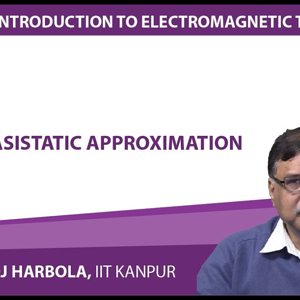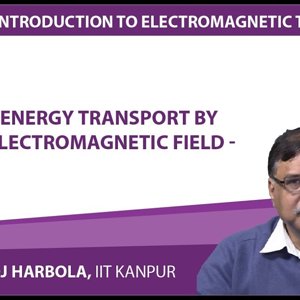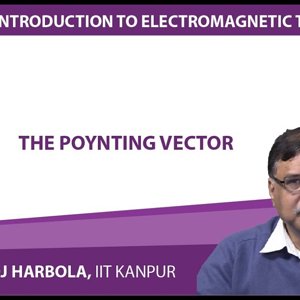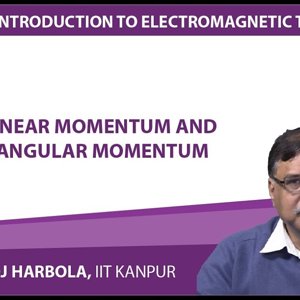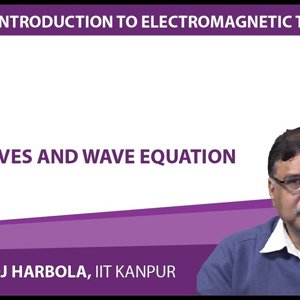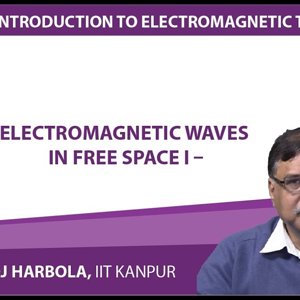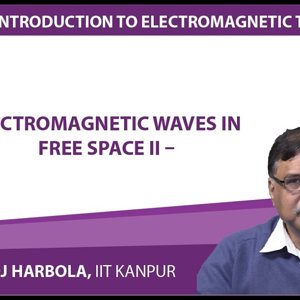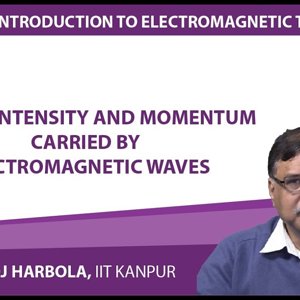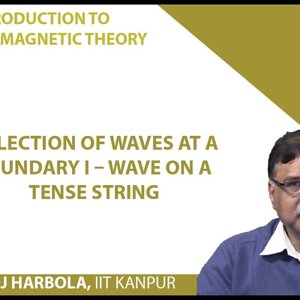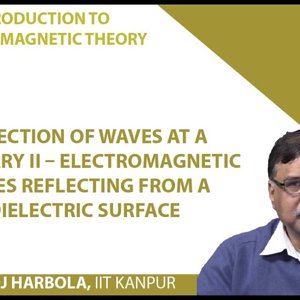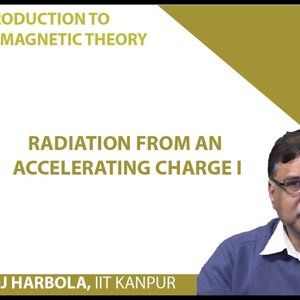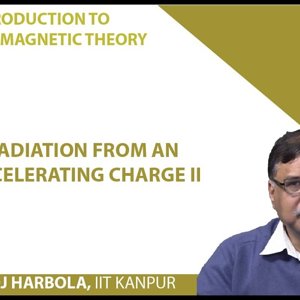Electromagetism Definition and 280 Threads
-
Introduction to Electromagnetism by Prof. Manoj Harbola (NPTEL):- Quasistatic approximation
Copyright strictly reserved to Prof. Harbola and Nptel, Govt. of India. Lectures: http://www.nptel.ac.in/courses/115104088/# Syllabus: http://www.nptel.ac.in/syllabus/115104088/- Wrichik Basu
- Media item
- electromagetism
- Comments: 0
- Category: Electromagnetism
-
Introduction to Electromagnetism by Prof. Manoj Harbola (NPTEL):- Energy transport by electromagnetic field
Copyright strictly reserved to Prof. Harbola and Nptel, Govt. of India. Lectures: http://www.nptel.ac.in/courses/115104088/# Syllabus: http://www.nptel.ac.in/syllabus/115104088/- Wrichik Basu
- Media item
- electromagetism
- Comments: 0
- Category: Electromagnetism
-
Introduction to Electromagnetism by Prof. Manoj Harbola (NPTEL):- The Poynting vector
Copyright strictly reserved to Prof. Harbola and Nptel, Govt. of India. Lectures: http://www.nptel.ac.in/courses/115104088/# Syllabus: http://www.nptel.ac.in/syllabus/115104088/- Wrichik Basu
- Media item
- electromagetism
- Comments: 0
- Category: Electromagnetism
-
Introduction to Electromagnetism by Prof. Manoj Harbola (NPTEL):- Linear momentum and angular momentum
Copyright strictly reserved to Prof. Harbola and Nptel, Govt. of India. Lectures: http://www.nptel.ac.in/courses/115104088/# Syllabus: http://www.nptel.ac.in/syllabus/115104088/- Wrichik Basu
- Media item
- electromagetism
- Comments: 0
- Category: Electromagnetism
-
Introduction to Electromagnetism by Prof. Manoj Harbola (NPTEL):- Waves and wave equation
Copyright strictly reserved to Prof. Harbola and Nptel, Govt. of India. Lectures: http://www.nptel.ac.in/courses/115104088/# Syllabus: http://www.nptel.ac.in/syllabus/115104088/- Wrichik Basu
- Media item
- electromagetism
- Comments: 0
- Category: Electromagnetism
-
Introduction to Electromagnetism by Prof. Manoj Harbola (NPTEL):- Electromagnetic waves in free space 1
Copyright strictly reserved to Prof. Harbola and Nptel, Govt. of India. Lectures: http://www.nptel.ac.in/courses/115104088/# Syllabus: http://www.nptel.ac.in/syllabus/115104088/- Wrichik Basu
- Media item
- electromagetism
- Comments: 0
- Category: Electromagnetism
-
Introduction to Electromagnetism by Prof. Manoj Harbola (NPTEL):- Electromagnetic waves in free space 2
Copyright strictly reserved to Prof. Harbola and Nptel, Govt. of India. Lectures: http://www.nptel.ac.in/courses/115104088/# Syllabus: http://www.nptel.ac.in/syllabus/115104088/- Wrichik Basu
- Media item
- electromagetism
- Comments: 0
- Category: Electromagnetism
-
Introduction to Electromagnetism by Prof. Manoj Harbola (NPTEL):- Energy, intensity and momentum carried by electromagnetic waves
Copyright strictly reserved to Prof. Harbola and Nptel, Govt. of India. Lectures: http://www.nptel.ac.in/courses/115104088/# Syllabus: http://www.nptel.ac.in/syllabus/115104088/- Wrichik Basu
- Media item
- electromagetism
- Comments: 0
- Category: Electromagnetism
-
Introduction to Electromagnetism by Prof. Manoj Harbola (NPTEL):- Energy and momentum carried by electromagnetic waves–examples
Copyright strictly reserved to Prof. Harbola and Nptel, Govt. of India. Lectures: http://www.nptel.ac.in/courses/115104088/# Syllabus: http://www.nptel.ac.in/syllabus/115104088/- Wrichik Basu
- Media item
- electromagetism
- Comments: 0
- Category: Electromagnetism
-
Introduction to Electromagnetism by Prof. Manoj Harbola (NPTEL):- Reflection of waves at a boundary 1 – wave on a tense string
Copyright strictly reserved to Prof. Harbola and Nptel, Govt. of India. Lectures: http://www.nptel.ac.in/courses/115104088/# Syllabus: http://www.nptel.ac.in/syllabus/115104088/- Wrichik Basu
- Media item
- electromagetism
- Comments: 0
- Category: Electromagnetism
-
Introduction to Electromagnetism by Prof. Manoj Harbola (NPTEL):- Reflection of waves at a boundary 2
Copyright strictly reserved to Prof. Harbola and Nptel, Govt. of India. Lectures: http://www.nptel.ac.in/courses/115104088/# Syllabus: http://www.nptel.ac.in/syllabus/115104088/- Wrichik Basu
- Media item
- electromagetism
- Comments: 0
- Category: Electromagnetism
-
Introduction to Electromagnetism by Prof. Manoj Harbola (NPTEL):- Radiation from an accelerating charge 1
Copyright strictly reserved to Prof. Harbola and Nptel, Govt. of India. Lectures: http://www.nptel.ac.in/courses/115104088/# Syllabus: http://www.nptel.ac.in/syllabus/115104088/- Wrichik Basu
- Media item
- electromagetism
- Comments: 0
- Category: Electromagnetism
-
Introduction to Electromagnetism by Prof. Manoj Harbola (NPTEL):- Radiation from an accelerating charge 2
Copyright strictly reserved to Prof. Harbola and Nptel, Govt. of India. Lectures: http://www.nptel.ac.in/courses/115104088/# Syllabus: http://www.nptel.ac.in/syllabus/115104088/- Wrichik Basu
- Media item
- electromagetism
- Comments: 0
- Category: Electromagnetism
-
R
Graduate Do photons carry the electric field?
In basic electrostatics any charged particle will produce an electric field at every point in space, and will have electric filed lines spreading out radially. E = kQ/r^2 The Standard model of particle physics says that the Photon is the force carrier for the Electromagnetic force, just like...- Robert Leslie
- Thread
- Elecrostatics Electric Electric field Electromagetism Field Photons Standard model
- Replies: 2
- Forum: Electromagnetism
-
W
Phase relation between the electric & magnetic fields in a plasma
Homework Statement So I have got the question below. I am asked to find the phase difference between the electric field and magnetic field of electromagnetic waves traveling in a plasma, using the electrical conductivity expression. Now I have found the frequency of the waves and I know that...- willidietomorrow
- Thread
- Electric Electrodynamics Electromagetism Fields Magnetic Magnetic fields Phase Plasma Relation
- Replies: 1
- Forum: Advanced Physics Homework Help
-
A
Is Solenoid Inductance Proportional to Turns Squared?
Homework Statement In Solenoid, is emf E= N. d(phi)/dt, or is it simply d(phi)/dt? Some books contain the latter one. It was not a big deal until i gave a thought about it. Since increasing the N, we are actually increasing the value of n, thus increasing B= (mu) .n.I So, by placing N in front...- Alin S
- Thread
- Electromagetism Emf Flux Solenoid
- Replies: 1
- Forum: Introductory Physics Homework Help
-

Magnetic field decay in cylinder coaxial with solenoid
Homework Statement For a medium of conductivity ##\sigma##: $$ \nabla^2 \vec{B} = \sigma \mu \mu_0 \frac{\partial \vec{B}}{\partial t} + \mu \mu_0 \epsilon \epsilon_0 \frac{\partial^2 \vec{B}}{\partial^2 t} $$ A long solenoid with ##r=b## has n turns per unit length of superconducting wire anc...- Alettix
- Thread
- Coaxial Cylinder Decay Electromagetism Field Magnetic Magnetic field Maxwell equations Solenoid
- Replies: 1
- Forum: Advanced Physics Homework Help
-

Input impedance of a "Ladder" transmission line
Homework Statement My electronics&physics lecture notes contain the following side note: ___ "A ladder transmission line comprises an alternating sequence of segments of two different transmission lines both of length $l$ with characteristic impedance $Z1$ and $Z2$. If the line is constructed...- Marcus95
- Thread
- Electromagetism Impedance Input Input impedance Line Transmission Transmission line Waveguide
- Replies: 3
- Forum: Introductory Physics Homework Help
-

Magnetic field in the gap of a tapered torus
Homework Statement Consider a toroidal electromagnet filled with a magnetic material of large permeability µ. The torus contains a small vacuum gap of length h. Over most of its length the torus has a circular cross section of radius R, but towards the gap the torus is tapered on both of its...- Alettix
- Thread
- Ampere's law Coil Electromagetism Field Gap Magnetic Magnetic field Maxwell Torus
- Replies: 9
- Forum: Introductory Physics Homework Help
-
Classical Book(s) with problems on classical electromagnetism
I started studying the book "A Student's Guide to Maxwell's Equations" by Daniel Fleisch some time back. It is an excellent book, giving a very good idea about the main laws of electromagnetism. I will soon finish the book. Now I need some book(s) which has problems on all the laws in classical...- Wrichik Basu
- Thread
- Ampere's law Classical Electromagetism Electromagnetism Faraday law Gauss law Maxwell equations
- Replies: 3
- Forum: Science and Math Textbooks
-
G
Potential of an undefinided cylinder
Homework Statement Determine the potential that creates an undefined cylinder of radius $R$ and density density $\rho$ that is uniformly charged. Homework Equations Gauss's law. The Attempt at a Solution I know that for this problem I can use gauss because it is a cylinder, now I do not get...- Guillem_dlc
- Thread
- Cylinder Electromagetism Gauss Potential
- Replies: 14
- Forum: Introductory Physics Homework Help
-

Undergrad Lorentz force and linear motors
I have a picture below please have a look at it. The guy is using two conducting rods placed parallel to each other and placed below it are magnets. When battey is connected to rods and a conductor is placed over them it starts to move.That works according to flemmings left hand rule. I was...- rishi kesh
- Thread
- Electromagetism Force Linear Lorentz Lorentz force Motors
- Replies: 1
- Forum: Electromagnetism
-
R
Undergrad Why don't we ever hear about low-frequency photons?
We're told that all electromagnetic radiation consists of photons. But you never hear them mentioned when discussing low-frequency radio waves. Why not? I get that, due to the low frequencies, the energy of each individual photon would be very small, so there must be lots and lots of them flying...- Rob Lewis
- Thread
- Electromagetism Photon Photons Radio frequency
- Replies: 12
- Forum: Quantum Physics
-
A
What is the Magnetic Flux of a White Dwarf Derived from the Sun?
Homework Statement The sun has a rotational period of 25 days. Finding the rotational period if it can shrink to form a white dwarf (##R_{WD}=10^3Km##). Knowing that the density of magnetic flux of the Sun on the surface is ##1 Gauss##, finding the magnetic flux of the white dwarf. Homework...- Aleolomorfo
- Thread
- Astrophysics Electromagetism Flux Magnetic Magnetic flux White dwarf
- Replies: 3
- Forum: Advanced Physics Homework Help
-

Find the time dependent magnetic field intensity
Homework Statement Calculate the time-dependent magnetic field intensity B(t) at an axial distance r from a long, thin straight copper wire that carries a sinusoidal current with an alternating frequency of 50 Hz and a maximum amplitude of 0.5 A. Homework Equations I = Asin(\omega t) B =...- TheBigDig
- Thread
- Current Electromagetism Field Intensity Magnetic Magnetic field Magnetic field intensity Time Time dependent
- Replies: 2
- Forum: Introductory Physics Homework Help
-
J
Graduate Conserved quantity for a particle in a homogeneous and static magnetic field
The equation of motion for a charged particle with mass ##m## and charge ##q## in a static magnetic field is: ##\frac{d}{dt}[m{\dot{\vec{r}}}]=q\ \dot{\vec{r}}\times \vec{B}## From this, we can see that ##\frac{d}{dt}[m\dot{\vec{r}}-q \vec{r}\times \vec{B}]=0## and so the following quantity is...- Joker93
- Thread
- Conservation laws Electromagetism Field Gauge transformation Homogeneous Magnetic Magnetic field Noether's theorem Particle Static Symmetries
- Replies: 1
- Forum: Electromagnetism
-
Electrical field near infinite, charged rod
Homework Statement Calculate the electric field at point ##P## if the distance from the center of an infinitely long, charged rod to point ##P## is ##a = 0.6m##; the charge density equals ##\lambda = -CX^2##, ##C=10^{-3}C/m^3##. Show all steps in finding the equation of the field, then find the...- klm_spitifre
- Thread
- Charged Charged rod Electrical Electrical field Electromagetism Field Infinite Rod
- Replies: 3
- Forum: Introductory Physics Homework Help
-

Undergrad Coulomb's law, electrostatics?
Equation: ΣF=Σk(qi)(qj)/(r^2) Question: Considering more than a couple of particles. How can a net force on a charged particle be calculated if Coulomb's law is under the restriction of static forces? Thanks!- Jurtinus
- Thread
- Coulomb's law Electro dynamics Electromagetism Electrostatic equilibrium Electrostatics Law
- Replies: 42
- Forum: Electromagnetism
-
A
Undergrad Does a rotating conductor generate a voltage change
Does a rotating conductor generate an electrical potential due to charges "feeling" a centrifugal force?- Alfalfa206
- Thread
- Angular momentum Centrifugal force Change Conductor Electrical potential Electromagetism Rotating Voltage
- Replies: 1
- Forum: Electromagnetism
-

Graduate How to predict the movement of a magnet in a magnetic field?
Can we predict the movement of a magnet in a uniform magnetic field using Maxwell's equations? What if the magnetic field is variable, for example if we have two magnets moving in a reference frame? Thank you for any answers and I wish you a Merry Christmas! :)- Cathr
- Thread
- Electromagetism Field Magnet Magnetic Magnetic field Magnets Movement
- Replies: 3
- Forum: Electromagnetism
-

Vector Potential of a Rotating Mangetic Dipole
Homework Statement A rotating magnetic dipole is built by two oscillating magnetic dipole moments, one along the y-axis and one along the x-axis. Find the vector potential at a point: (0, 0, ##z_0##) along the z-axis. Then find the magnetic field at ##z_0## . As the magnetic field is a function...- allison west
- Thread
- Dipole Electromagetism Magnetic dipole moment Magnetic field Potential Rotating Vector Vector potential
- Replies: 5
- Forum: Advanced Physics Homework Help
-

Power Transmitted in a Coaxial Cable
Homework Statement A coaxial transmission line consists of an inner cylindrical conductor of radius a = 1 mm and a cylindrical outer conductor chosen to make the characteristic impedance 75 ohm. The space between the conductors is lled with a gas which can stand a maximum eld of 105 V/m without...- Marcus95
- Thread
- Cable Coaxial Coaxial cable Dielectric breakdown Electromagetism Power Transmission line
- Replies: 7
- Forum: Introductory Physics Homework Help
-
C
Magnetostatics - Magnetic field of a nonuniform current slab
Homework Statement A thick slab in the region 0 \leq z \leq a , and infinite in xy plane carries a current density \vec{J} = Jz\hat{x} . Find the magnetic field as a function of z, both inside and outside the slab. Homework Equations Ampere's Law: \oint \vec{B} \cdot d\vec{l} = \mu_0...- cmo2978
- Thread
- Ampere's law Current Current density Electromagetism Field Magnetic Magnetic field Magnetostatics
- Replies: 5
- Forum: Introductory Physics Homework Help
-

Undergrad Can the Electromagnetic Force be Explained by Curving Spacetime?
So General Relativity explains the force of gravity as mass/energy induced curvature of spacetime. This correctly predicts gravitational time distortion, nonlinear geodesics and gravitational lensing, the anomalous precession of planetary orbits, the schwarzchild metric, and so on. Could the...- dreens
- Thread
- Curvature E&m Electromagetism General relativity Spacetime
- Replies: 11
- Forum: Beyond the Standard Models
-

Graduate Is the Work Done in Charging an Inductor Different in Non-Quasistatic Scenarios?
As we know, work done by an outside agency in creating some current ''I" in an inductor 'L' is 1/2LI2. Now this result is derived by quasistatic approximation if I am not wrong. Now, I am assuming that in non quasistatic (real) scenarios, the work done by outside agency would be different(If you...- mayank pathak
- Thread
- Electromagetism Energy Inductance Magnetic Magnetic energy Poynting vector Quasi-static
- Replies: 9
- Forum: Electromagnetism
-
P
How does the differential form of Faraday's law relate to induced current?
Homework Statement I'm in a class where we have to essentially learn E&M ourselves and I'm challenged by Maxwells equations. I'm studying out of Purcell's E&M. The differential form of Faradays law for Maxwells equations is curl E = -∂B/∂t Im having trouble interpreting what to make of this...- PhysicsInNJ
- Thread
- E&m Electromagetism Faraday's law Induction Law
- Replies: 5
- Forum: Advanced Physics Homework Help
-

Basics of radio for a focused transmitter
Hi there! I'm looking to create a small (max 20 foot range) radio transmitter, to direct a focused radio beam at a receiver, for the purpose of remote switching. Ideally, I would like the device to work at a relatively "exotic" frequency, as I would think there is a lot of radio noise where I...- OldWorldBlues
- Thread
- Basics Electrcity Electromagetism Radio Transmitter
- Replies: 12
- Forum: Electrical Engineering
-
C
Undergrad Electrical Current Repelling Magnets Due to Relativity
I recently watched this Varitasium video where he explains the magnetic field due to a current carrying wire. In the video he explains how what we see and describe as the magnetic field produced by a current carrying wire is actually just a electric force caused by the an imbalance of charges...- Cardinalmont
- Thread
- Current Electrical Electromagetism Magnets Relaitivity Relativity
- Replies: 8
- Forum: Special and General Relativity
-
G
Coaxial cable conductors with dielectric: polarization of charge
Homework Statement Consider a coaxial cable which consists of an inner cylindrical conductor of radius R1, and a shell cylindrical conductor of radii R2 and R3. The 2 conductors are separated with a dielectric material of permittivity ε. Consider the length of the cable, ℓ, much larger than R3...- Granger
- Thread
- Cable Charge Coaxial Coaxial cable Conductors Dielectric Electromagetism Polarization
- Replies: 10
- Forum: Introductory Physics Homework Help
-
G
Is the Total Charge of Polarization in a Non-Homogeneous Dielectric Zero?
Homework Statement Consider an infinite environment with electrical permittivity non-homogeneous $$\epsilon=\epsilon_0(1+a/r)$$ a being a positive constant. A conducting sphere of radius R and charge Q is put on that environment, centered at r=0. Determine the electric field $$E$$, the...- Granger
- Thread
- Charge Dielectric Electromagetism Total charge
- Replies: 2
- Forum: Introductory Physics Homework Help
-
G
Electric field in a capacitor with a dielectric
Homework Statement A parallel plate capacitor has 2 square plates of side l, separated by a distance d (l is a lot bigger than d). Between the plates, there is a linear and non-homogeneous dielectric with constant $$\epsilon_R=1+ay$$ with $$a$$a positive constant. Calculate the electric field...- Granger
- Thread
- Capacitor Dielectric Electric Electric field Electromagetism Field
- Replies: 5
- Forum: Introductory Physics Homework Help
-
P
Induced Electric Field In Circuit With Varying Resistance
Homework Statement This is irodov's problem #310 in electrodynamics A long solenoid of cross-sectional radius a has a thin insulated wire ring tightly put on its winding; one half of the ring has the resistance ## \beta ## times that of the other half. The magnetic induction produced by the...- PumpkinCougar95
- Thread
- Circuit Electric Electric field Electromagetism Field Induced Induced electric field Resistance
- Replies: 3
- Forum: Introductory Physics Homework Help
-
H
Four carbon brushes for a DC Motor- what are they for?
Hi in every theoretical explanation of any kind of DC motor there's always a split ring commutator and two brushes like in the following pic then when it comes to my motorbike/car starter motor rebuild the real thing in practice is different- see the following pic with four carbon brushes- two...- Hondaboi1729
- Thread
- Carbon Dc Dc motor Electromagetism Magnetism Motor
- Replies: 12
- Forum: Electrical Engineering
-

Are ALL parallel plate capacitors linear?
Homework Statement Are ALL parallel plate capacitors linear? Homework Equations D = permittivity * E The Attempt at a Solution Capacitance is linear if permittivity is constant. Is there a case where a parallel plate capacitor is not linear?- lonelypancreas
- Thread
- Capacitor Capacitors Electromagetism Linear Parallel Parallel plate Plate
- Replies: 2
- Forum: Introductory Physics Homework Help
-
W
Graduate Correlation between potential energy and torque
In class while learning about electromagnetism, I was given the following two equations: U=-μ⋅B τ=μ×B where μ=IA First of all, what does μ stand for? How should I interpret the relationship between potential energy (U) and torque? Can someone explain this in terms of μ and B?- wjdgone
- Thread
- Correlation Electromagetism Energy Magnetic field Potential Potential energy Torque
- Replies: 1
- Forum: Mechanics
-

Graduate Difference between conduction & convection current density?
Hello Everyone, Could anyone please explain the difference between the conduction current density (J=σE) and the convection current density (J=ρvd)? I really appreciate any examples or applications to further elaborate these two theories. Note: vd is the particles' average drift velocity...- sams
- Thread
- Conduction Convection Current Current density Density Difference Electrodynamics Electromagetism
- Replies: 7
- Forum: Atomic and Condensed Matter
-
S
Graduate Correction to the field energy due to the existence of discrete charges
In the classical electromagnetic field theory, the field density of energy is given by: $$u = (\epsilon/2)E^2 + (\mu/2)H^2$$ One of the differences between the classical electromagnetic theory and the real world is that in classical EM all charge and current density, (ρ(r), J(r)), is...- SergioPL
- Thread
- Charges Correction Discrete Electro static Electromagetism Energy Existence Field
- Replies: 2
- Forum: Electromagnetism
-
E
Undergrad Railgun: Problems with reality check
So I was doing some calculations last night on railguns for fun, and I got some very surprising results which seams like they must be wrong. The calculations are simple and I must have overlooked something. So we all know that F = B * I * L when all are orthogonal, a capacitor discharge is I =...- Elon
- Thread
- Electromagetism Railgun Realism Reality
- Replies: 8
- Forum: Electromagnetism
-
C
Graduate Continuum mechanical analogous of Maxwell stress tensor
Maxwell stress tensor ##\bar{\bar{\mathbf{T}}}## in the static case can be used to determine the total force ##\mathbf{f}## acting on a system of charges contanined in the volume bounded by ##S## $$ \int_{S} \bar{\bar{\mathbf{T}}} \cdot \mathbf n \,\,d S=\mathbf{f}= \frac{d}{dt} \mathbf...- crick
- Thread
- Continuum Continuum mechanics Electromagetism Maxwell maxwell stress Mechanical Stress Stress tensor Tensor
- Replies: 1
- Forum: Electromagnetism
-
P
Graduate Light-beam propagation across impassable barrier?
Hi all, (See attached image file) Two mutually coherent and collimated light beams intersect as shown, creating the stationary 'bright' and 'dark' fringes of fig.A. Suppose that, after the fringe pattern has formed, we insert a very thin (compared to the fringe-width) and (ideally) perfectly...
